|
August 1956 Popular Electronics
 Table of Contents Table of Contents
Wax nostalgic about and learn from the history of early electronics. See articles
from
Popular Electronics,
published October 1954 - April 1985. All copyrights are hereby acknowledged.
|
The Semi-Automatic Ground
Environment (SAGE) system was designed and built to monitor the flights of both
intercontinental ballistic missiles and hostile aircraft - if they were ever to
occur, which, thankfully, they did not. Nuclear bombs were of particular interest
since they could be launched not just from the USSR, which was the only other nuclear
power in 1956, but also from offshore aircraft carriers and submarines. This was
the beginning of the era when school kids participated in practice drills of getting
under their desks in the event of an attack. I remember doing it in the mid 1960s
while in grade school. Some of the equipment described here represents the earliest
computerized digital technology, including magnetic core memory. This 1956 issue
of Popular Electronics magazine reports on the system. According to the
Wikipedia entry, SAGE did not go into full operation until 1958.
RF Cafe visitor Joseph B. just sent me a link to an article entitled, "The
Most Important Computer You've Never Heard Of." It is a great technical look
in the rear view mirror of the success of this look through the front
windshield. Plenty of photos are included of the vacuum tube-based AN/FSQ-7
digital computer. Note all the operators are high-ranking NCOs.
SAGE - Whirlwind Defense Quarterback Goes into Operation

Direction center and computer are housed in this windowless, reinforced concrete
blockhouse at Lincoln Laboratory - the nerve center of the SAGE system.
Department of Defense Photos
By E. D. Morgan
Plunging through the enemy line of aerial and atomic attack, SAGE is ready to
make a touchdown for national defense
The destructive power of atomic warfare coupled with the growing array of aerial
weapons which could reach our shores raises frightening misgivings. A swift and
efficient defense must be instantly available to counter an attack if we are to
survive. Fortunately, the same brand of ingenuity that developed these offensive
means has been working to give us the weapons and organized control of them that
a defense requires.
The task of assignment and control of interceptors, ground-to-air guided missiles,
and anti-aircraft guns - the means by which we must defend ourselves - has led to
the development of a huge electronic quarterback called the "SAGE" system. The name
"SAGE" is derived from its more formal title, the Semi-Automatic Ground Environment
system.
Directing Defense. One of the world's largest, fastest and brightest
electronic computers is the heart of this fantastic system. It relieves men of the
hopeless task of sorting, weighing and evaluating the thousands of pieces of information
our radar networks and other detection means can supply. It determines the best
assignments of our defensive means to cope with the situation. Then, it directs
these aerial weapons until the attacking plane or missile is downed.

The computer which forms the nucleus of the SAGE system is known
as an AN/FSQ-7. One of the world's largest and fastest, it contains 25,000 vacuum
tubes. Maintenance console is shown above.
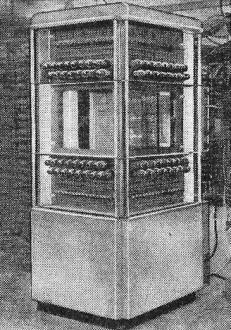
Memory unit of computer, made up of three-dimensional array of ferrite cores,
receives a constant stream of flight data.
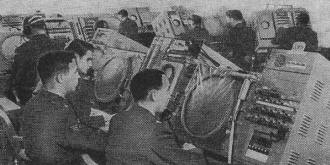
Cathode-ray tubes are used to display composite pictures of the
changing air situation in a television-like manner. Locations of all aircraft and
their identifications can be observed. The consoles at the left are part of Whirlwind
I, a forerunner of the present computer.
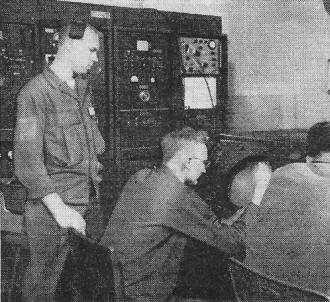
Electronic equipment shown above is installed in one of the gap-filler
radar stations which are located between more powerful long-range search transmitters.
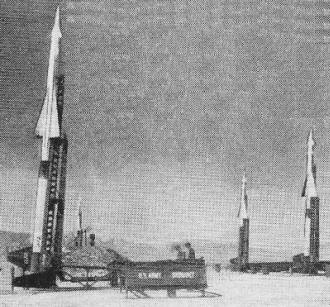
Ground-to-air guided missiles are a key factor in our defense.
A "Nike" battery, shown ready for firing, can locate and destroy enemy aircraft
by means of electronic brain. The "Nike" is the nation's first combat-ready surface-to-air
guided missile.
The first of these fabulous systems is centered at Lincoln Laboratory in Lexington,
Mass. At this secret laboratory, operated by the Massachusetts Institute of Technology,
the system was conceived and developed for the military forces. In all, 32 similar
systems will be constructed, protecting our borders with the largest electronic
defensive system ever constructed.
At the outer boundaries of the system is a ring of radar detection stations.
Long-range surveillance radars and height finders are included, as well as smaller
gap-filler radars to detect low-flying planes trying to slip beneath the skirts
of the longer range detection systems.
The edge of the system is not confined to coverage from land stations, however;
"Texas Towers" constructed far from the shore extend the coverage seaward. These
man-made islands are huge platforms standing on legs which reach to the ocean floor.
Their name comes from a technique used successfully for offshore oil well rigs in
the gulf of Mexico.
Other seaward defensive lines are manned by radar picket ships and AEW (Airborne
Early Warning) planes carrying powerful radars. Constant patrols insure that the
system remains on the alert.
Interpreting Signals. The mass of information provided by these surveillance
systems is transmitted continuously and automatically by either telephone lines
or ultra-high-frequency radio networks to a direction center.
Also pouring into this direction center is additional data from other sources:
flight plans of friendly aircraft to aid in their identification, up-to-date weather
data vital to the successful interception of an enemy, reports from the Ground Observer
Corps, data on the readiness of our defensive weapons, etc.
This constant stream of courses, speeds, altitudes and locations is continually
digested by the computing facilities. The direction center is located in a windowless
concrete blockhouse. It houses the dual-channel computer built by IBM. One channel
is on a standby basis, but all the pertinent information is fed into it so that
it is immediately ready for action if necessary.
The computer busily compares reports and compiles, sorts and processes the input
information. Composite pictures of the air situation are displayed on 30" cathode-ray
tubes in a television-like manner. Locations of all aircraft and their identifications
can be observed. In addition, the computer weighs all the possible means of eliminating
enemy planes or missiles and indicates them. The different weapons that might be
used, and the time and place of the interception, are all available to the men making
the tactical decisions.
When a particular type of defensive strategy is decided upon, the computer continues
its work. It can direct an interceptor or missile until it contacts the enemy. If
radio data links and automatic pilots are in an interceptor, it actually flies the
plane to its destination. After the kill has been made, the computer continues its
task to bring the plane back to its home base.
If the air battle nears the boundary of a particular system, it transfers the
problem to the computer in the adjacent sector. With its speed, accuracy and capacity,
it can handle many intercepts simultaneously while continuing its function of surveillance.
Over-All Picture. The immensity of the task has involved the
cooperation of companies like Western Electric, IBM, Bell Labs, Burroughs and Rand
along with Lincoln Laboratory.
The computer contains 25,000 vacuum tubes and covers 10,000 square feet. While
it is supervised and monitored by men, it releases them from the overwhelming task
of coping with thousands of details. This frees them for the more important job
of making tactical decisions. Even in this category, they are guided and aided by
the electronic machines.
SAGE changes the basic building block in our defense picture from a single radar
and its operator to an entire geographical area treated as a unit. The capacity
and efficiency of this technique serve to keep our defensive ability in step with
the growing offensive might which may someday be directed against us.
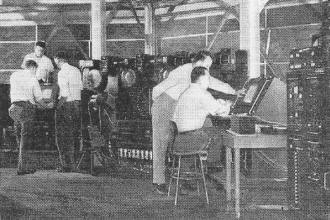
Many radar locations have control centers where the search and
height-finding radars work as a team (right). The information is then relayed to
the system's direction center for processing.
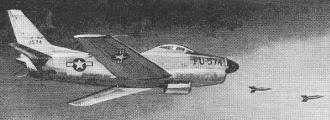
Interceptors like this all-weather F-86D Sabre provide one
means of downing enemy planes. The SAGE computer is
capable of flying the plane to its destination using a u.h.f.
data link and automatic pilot. "Mighty Mouse" 2.75 - inch
rockets are fired from a retractable pod beneath the fuselage.
Posted June 6, 2022
(updated from original post on 11/28/2016)
|

















